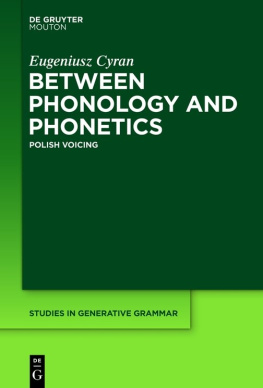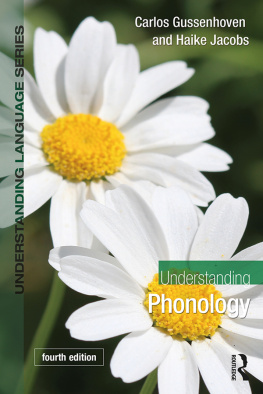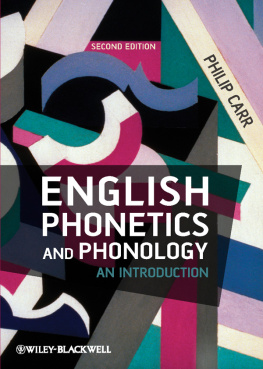Alan Bale - Phonology : a formal introduction
Here you can read online Alan Bale - Phonology : a formal introduction full text of the book (entire story) in english for free. Download pdf and epub, get meaning, cover and reviews about this ebook. City: Cambridge, year: 2018, publisher: The MIT Press, genre: Home and family. Description of the work, (preface) as well as reviews are available. Best literature library LitArk.com created for fans of good reading and offers a wide selection of genres:
Romance novel
Science fiction
Adventure
Detective
Science
History
Home and family
Prose
Art
Politics
Computer
Non-fiction
Religion
Business
Children
Humor
Choose a favorite category and find really read worthwhile books. Enjoy immersion in the world of imagination, feel the emotions of the characters or learn something new for yourself, make an fascinating discovery.

- Book:Phonology : a formal introduction
- Author:
- Publisher:The MIT Press
- Genre:
- Year:2018
- City:Cambridge
- Rating:4 / 5
- Favourites:Add to favourites
- Your mark:
- 80
- 1
- 2
- 3
- 4
- 5
Phonology : a formal introduction: summary, description and annotation
We offer to read an annotation, description, summary or preface (depends on what the author of the book "Phonology : a formal introduction" wrote himself). If you haven't found the necessary information about the book — write in the comments, we will try to find it.
Phonology : a formal introduction — read online for free the complete book (whole text) full work
Below is the text of the book, divided by pages. System saving the place of the last page read, allows you to conveniently read the book "Phonology : a formal introduction" online for free, without having to search again every time where you left off. Put a bookmark, and you can go to the page where you finished reading at any time.
Font size:
Interval:
Bookmark:
Phonology
A Formal Introduction
Alan Bale
Charles Reiss
The MIT Press
Cambridge, Massachusetts
London, England
2018 Massachusetts Institute of Technology
All rights reserved. No part of this book may be reproduced in any form or by any electronic or mechanical means (including photocopying, recording, or information storage and retrieval) without permission in writing from the publisher.
For information about special quantity discounts, please email special sales@mitpress.mit.edu.
This book was set in Times by the authors.
Printed and bound in the United States of America.
Library of Congress Cataloging-in-Publication Data
Names: Bale, Alan. | Reiss, Charles author.
Title: Phonology: a formal introduction / Alan Bale and Charles Reiss.
Description: Cambridge, MA: The MIT Press, 2018. | Includes bibliographical references and index.
Identifiers: LCCN 2017057051 | ISBN 9780262038386 (hardcover: alk. paper)
Subjects: LCSH: Grammar, Comparative and generalPhonology.
Classification: LCC P217.B25 2018 | DDC 414dc23
LC record available at https://lccn.loc.gov/2017057051
d_r0
This book is dedicated to the memory of Morris Halle.
13Introducing Neutralization
21.7Combined Neutralization
30.5More Complex SMDs
VIIIFeatures and Feature Logic
49.3Segment Mapping Diagrams and the
Two-Step Process
53Turkish Vowel Harmony I
Index
Complementary distribution for Oxyurian.
Complementary distribution for Dhori.
No rule; s and occur everywhere in Tocaribe.
Neutralization by rule s / i in Dengue.
No rule; s and occur aside from accidental gaps in English.
Comparison of y = log102n and y = log103n.
Some feature values for common consonants.
Authorship of any sort is a fantastic indulgence of the ego. It is well, no doubt, to reflect on how much one owes to others.
John Kenneth Galbraith, The Affluent Society
We are grateful to the many colleagues who have influenced this book, either through conversation or through our familiarity with their work, including other excellent introductions to phonology. Eric Bakovi must be singled out for his interest and encouragement over the course of this project. Some of the material here derives from research developed over many years with Mark Hale, so he too deserves special thanks. Brendan Gillon and Dana Isac offered sympathetic ears and good advice during the long thinking and writing process. Pter Siptrs careful reading of a late draft saved us from a lot of embarrassing mistakes. Our copy editor, Mary Calvez, caught errors and helped us clarify the writing in many parts of a long and difficult manuscript.
A number of younger scholars and former studentsMaxime Papillon, Bridget Samuels, David Ta-Chun Shen, Frdric Mailhot, Sigwan Thivierge, Veno Volenec, September Cowley, Ollie Sayeed, Thomas Graf, and Karthik Durvasulahave influenced our thinking. Dariia Dziuba created a bank of html exercises and also provided useful suggestions and corrections over the course of many revisions. Hisako Noguchis acumen, both linguistic and stylistic, has improved the book considerably.
A reviewer commented on an unsuccessful grant application for an early stage of this work that Students wont be inspired to study linguistics through set theory, but rather through hip-hop music. Over the years, many students who like both set theory and hip-hop music have assured us that it was the former that kept them in linguistics. We appreciate the vindication.
Perhaps you have no idea what the words pangolin and maypop mean. However, if we told you that both words are nounsthe first is a kind of animal (also called a scaly anteater) and the second a kind of flower (also called a purple passionflower) you would have no problem creating plural forms for each word. In writing, you would probably guess pangolins and maypops. One noteworthy fact about these words is that the plural markers, written as -s in both forms, sound different. If you say pangolins, you will notice that the sound at the end of the word sounds like the beginning of zinc, whereas if you say maypops, the sound at the end of the word sounds like the beginning of sink. This distinction is an example of a phonological fact about your language. In this book we take the position that the study of such facts, the study of phonology, is a branch of cognitive science that ultimately can serve as a form of theoretical neuroscience.
This suggestion, that phonology is relevant to theoretical neuroscience, might strike you as outrageous. However, once we consider that you had to use your mind to come up with the plural forms for those previously unknown words, and that the mind is somehow closely related to the brain, our apparently controversial characterization of phonology becomes a platitude: our linguistic behavior, like all of our behavior, is highly dependent on our mind/brain and thus ultimately has to be compatible with the correct theory of our brains.
This is not to say we will be talking about neurotransmitters or networks of cells in this book. We wish we could; we wish phonology were at a stage where we could link our phonological knowledge to neurological states. Unfortunately it is not. No one has identified correspondences between linguistic sounds and neurological patterns. No one yet understands the correlations between a specific set of neurons firing and the representation of syllables, stress patterns, or tone, and it is not even clear that this is the right kind of correlation to look for. The study of the relationship between activity in the brain and language, or in fact any other kind of cognition, is in its infancy. However, our ambitious goal in this book is to introduce you to phonology as a useful step toward a future unification of cognitive science and neuroscience. As Gallistel and King (2009, p. vii) put it, The truths the cognitive scientists know about information processing, when integrated into neuroscience, will transform our understanding of how the brain works.
Prior to figuring out how the brain works at the (sub-)neurological level, we must first understand what the brain does: What kind of information does it store and process, and what kind of operations does it perform on this information? Our focus will be on the information structures that are storedthe representationsand the operations that are performedthe rulesin the domain of phonology.
As phonologists interested in unifying our field with other branches of cognitive science, our job is to formulate theories using terms and concepts that are accessible to specialists in fields like psychology and neuroscience. With this in mind, we have attempted to build phonological theories out of a general logical and mathematical toolbox containing functions, sets, set operations, and variables. Theories built with these tools can be easily translated to precise algorithms. Precise algorithms, in turn, should ultimately make it easier to associate neurological states and activity with phonological cognition.
It is important to note that pursuing phonological theory in this way opens the door to making connections between phonological processes and other kinds of cognition. Once we state our phonological patterns in such general terms, neuroscientists can try to figure out how functions, sets, set operations, and variables can be implemented in biological systems more generally. This basic mathematical toolbox can describe a variety of cognitive behavior, from higher level concept formation to insect navigation systems. This generality could mean that studying the neurology of a wasp making her way home might tell us something about what goes on in your brain when you say
Font size:
Interval:
Bookmark:
Similar books «Phonology : a formal introduction»
Look at similar books to Phonology : a formal introduction. We have selected literature similar in name and meaning in the hope of providing readers with more options to find new, interesting, not yet read works.
Discussion, reviews of the book Phonology : a formal introduction and just readers' own opinions. Leave your comments, write what you think about the work, its meaning or the main characters. Specify what exactly you liked and what you didn't like, and why you think so.






